201871010124-王生涛《面向对象程序设计(java)》第四周学习总结
|
项目 |
内容 |
|
这个作业属于哪个课程 |
<任课教师博客主页链接>https://www.cnblogs.com/nwnu-daizh/ |
|
这个作业的要求在哪里 |
<作业链接地址>https://www.cnblogs.com/ws-t/ |
|
作业学习目标 |
掌握类与对象的基础概念,理解类与对象的关系; 掌握对象与对象变量的关系; 掌握预定义类Date、LocalDate类的常用API; 掌握用户自定义类的语法规则,包括实例域、静态域、构造器方法、更改器方法、访问器方法、静态方法、main方法、方法参数的定义要求; 掌握对象的构造方法、定义方法及使用要求;(重点); 理解重载概念及用法; 掌握包的概念及用法;
|
第一部分:总结第四章理论知识
1、面向对象程序设计概述:面向对象程序设计(OOP)是一种新的程序设计思维,这种方法更接近人类处理现实世界问题的自然表示方法。
(1)对象是面向对象编程的核心,是具体实体,具有明确定义的状态和行为。
(2)对象的三个主要特征:
1)行为:可以对对象施加哪些操作或者可以使用哪些方法;
2)状态:当施加那些操作或者方法时,对象应该如何应对;
3)标识:如何辨别具有相同行为和状态的不同对象。
2、类(class)
(1)类是具有相同属性和行为的一组对象的集合;
(2)类是描述对象的模板,它定义一类对象所拥有的数据和能完成的操作,在面向对象的程序设计中,类是构造程序的基本单位;
(3)每个类由一组结构化的数据(称作实例域)和在其上的一组操作构成。
3、如何识别类:
(1)过程化程序设计,必须从顶部的main函数开始编写程序;
(2)oop的思路,首先从设计类开始,然后在每个类里面添加方法;
(3)识别类简单规则是在问题分析过程中寻找名词,而类的方法则对应动词。
4、类和对象的关系:
(1)类是对象的原型,对象是类的实例,类是同类对象的抽象;
(2)所有属于同一个类的对象都具有相同的特征和操作。
5、类之间的关系:
(1) 依赖:如果一个类中的方法操作了另一个类的对象,那么这个类就依赖于另一个类;
(2)聚合:类A的对象包含类B的对象;
(3)继承:表示一个特定类和一个 一般类之间的关系。
一般来说, 如果类A继承了类B,那么类A 不仅有类B的方法与状态,还有属于自己的 状态与方法。
6、表达类关系的UML符号:
7、预定义类的使用:
(1)已学过的预定义类:Math类、math类、String类、Scanner类;
(2)要使用预定义类的方法,只需知道方法名和参数即可,无需了解它的内在实现过程;
(3)使用预定义类需要在程序开始处用import命令导入该类所在的包路经。
8、对象与对象变量:
(1)在oop中,要想使用对象,就必须首先构造对象,并初始化对象的状态,然后通过对象调用类中的方法;
(2)Java中,用构造器构造并初始化对象;
(3)构造器是类中一个特殊的方法,该方法与类名相同。不需要提供返回值;
(4)构造并初始化对象的格式:
new 构造器名(参数)
9、对象的初始化实例:
(1)Date类,定义在Java标准类库的Java.util包中;
(2)初始化Date类对象的实例:
new Date();
System.out.println(new Date());
(3)可以在类中一个方法用于新创建的对象:String s = new Date().toString();
10、对象变量:
(1)如果要多次使用初始化的变量,可将初始化后的变量放在一个对象变量中;
格式: Date birthday = new Date();
(2)对象变量保存对象后,可用对象变量引用对象;
System.out.println(birthday.toString());
(3)可将一个对象变量设置为NULL,表示该对象变量未引用任何对象。
11、更改器方法和访问器方法:
(1)一个类中对实例域进行修改的方法,更改器前面加set;
(2)一个类中对实例域进行访问的方法,前缀get。
12、用户自定义类:
(1)类的定义包括两部分内容:声明和类体
(2)类体由两部分构成:
一为实体域(或成员变量)定义;二为方法定义。
(3)域的定义:
1)实例域:类定义时实例域部分所定义的变量;
2)局部变量:方法体中定义的变量和方法的参数;
3)实例域的隐藏性:局部变量与实例域名字相同时,则实例域被隐藏,即在这个方法内暂时失效。
4)实例域的有效性:在整个类内部有效,而局部变量只在定义它的方法内有效。
5)私有实例域的更改器和访问器:有时需要获得或设置私有实例域的值,此时需提供下面三项内容:
a)一个私有的数据库;
b)一个共有的域访问器方法;
c)一个共有的域访问器方法;
6)final实例域:
可以将实例域定义为final,此类域构建对象时时必须进行初始化;即必须确保在构造器执行之前,这个域的值被设置,并且在后面的操作中,不能再对它的值进行修改,即该域无修改器。
final修饰符多用于基本数据类型域,或不可变类的域;
7)方法定义:
a)包括方法声明和方法体;
b)方法的声明:名字,类型和参数等属性的说明:方法的类型描述的数返回值类型;
c)方法体由局部变量和Java语句构成;一个类中可以有多个方法具有相同的名字,不同的类型,不同的参数,这种情况叫重载;
13、构造器:用来构造并初始化对象。
(1)构造器的名字必须要与它所在类名字相同;
(2)每个包可以由一个以上的构造器;
(3)构造器可以由一个,一个以上的参数;
(4)构造器没有返回值;
(5)构造器总是被new运算符调用;
14、(1)静态域:绝大多数面向对象程序设计语言中,静态域被称为类域。
如果将域定义为static,每个类中只有一个这样的域。而每个对象对于所有的实例域却都有自己的一份拷贝。
(2)main方法:main方法不对任何对象进行操作。静态的main方法将执行并创建程序所需要的对象。
(3)静态常量:静态变量用的少,但是静态常量用的多。
(4).静态方法:用修饰的方法叫静态方法或类方法,静态方法可通过类名或对象来调用,而其他方法只能通过对象来调用。静态方法不能操作对象,不能在静态方法中访问实例域。但静态方法可以访问自身类中的静态域。可以认为静态方法是没有this参数的方法,而在一个非静态方法中,this参数是表示这个对象/对象构造器的隐式参数。
15、对象的定义:使用一个类创建一个对象时,即创建了一个类的实例域。只有通过对象才可以访问该域的公共实例域,调用类中共有的方法;
16、类的导入:一个类可以直接使用它所在的包中的所有类,也可以使用来自其他包中的所有public类。
(1)静态导入:import语句不仅可以导入类,还增加了静态导入方法和静态域的功能;
(2)将类放如包中:首先用package语句指明报的名字,且该语句应为程序的第一条语句,然后才是定义类的语句;
(3)如果源文件不使用package语句指明包名,源文件的类将属于默认包。
(4)当一个源文件中使用了package语句时,那么这个包中所有的类文件的都必须放在与包名相匹配的目录中;
(5)当程序中所使用的类位于不同包时,起源问价和类文件必须如下组织;
17、包作用域:
(1)类中标记为public的部分可以被任意类使用;
(2)类中标记为private的部分只能在类中使用;
(3)如果没有为类、方法或实例域指定访问控制修饰符public或private,这部分可以被同一包中的所有方法访问;
(4)如果实例域不标记为private,将默认为包可见,这样做会破坏类的封装性。
18、类路径:
(1)类存储在文件系统的子目录中,类得路径必须与包名匹配;
(2)在命令行方式下,设置类路径,使用-classpath选项指定类路径。
第二部分:实验部分
实验名称:实验三 类与对象的定义及使用
1. 实验目的:
(1) 熟悉PTA平台线上测试环境;
(2) 理解用户自定义类的定义;
(3) 掌握对象的声明;
(4) 学会使用构造函数初始化对象;
(5) 使用类属性与方法的使用掌握使用;
(6) 掌握package和import语句的用途。
3. 实验步骤与内容:
实验1
采用个人账号登录https://pintia.cn/,使用绑定码620781加入PTA平台NWNU-2019CST1教学班(西北师范大学 计算机科学与工程学院 2018级计算机科学与技术),完成《2019秋季西北师范大学面向对象程序设计程序设计能力测试1》,测试时间50分钟。
实验1.1
公民身份证号码按照GB11643—1999《公民身份证号码》国家标准编制,由18位数字组成:前6位为行政区划分代码,第7位至14位为出生日期码,第15位至17位为顺序码,第18位为校验码。从键盘输入1个身份证号,将身份证号的年月日抽取出来,按年-月-日格式输出。注意:输入使用Scanner类的nextLine()方法,以免出错。
输入样例:
34080019810819327X
输出样例:
1981-08-19
程序代码:
|
1 2 3 4 5 6 7 8 9 10 11 12 13 14 15 16 17 |
import java.util.Scanner; public class test1 {
public static void main(String[] args) { // TODO Auto-generated method stub Scanner in = new Scanner(System.in); System.out.println("please input your ID:"); String s1 = in.nextLine(); String s2,s3,s4; s2 = s1.substring(6, 10); s3 =s1.substring(10, 12); s4 = s1.substring(12, 14); System.out.println(s2+"-"+s3+"-"+s4); } } |
运行结果如图:

实验1.2
studentfile.txt文件内容是某班同学的学号与姓名,利用此文件编制一个程序,将studentfile.txt文件的信息读入到内存,并提供两类查询功能:(1)输入姓名查询学号;(2)输入学号查询姓名。要求程序具有友好人机交互界面。
编程建议:
(1)从文件中读入学生信息,可以编写如下函数:
public static void StudentsFromFile(String fileName))
(2)输入姓名查找学生学号,可以编写如下函数:
public static String findStudent(String name)
(3)输入学号查找学生姓名,可以编写如下函数:
public static String findStudent(String ID)
程序代码:
|
1 2 3 4 5 6 7 8 9 10 11 12 13 14 15 16 17 18 19 20 21 22 23 24 25 26 27 28 29 30 31 32 33 34 35 36 37 38 39 40 41 42 43 44 45 46 47 48 49 50 51 52 53 54 55 56 57 58 59 60 61 62 63 64 65 66 67 68 69 70 71 72 73 74 75 76 77 78 79 80 81 82 83 84 85 86 87 88 89 90 91 92 93 94 95 96 97 98 99 100 101 102 103 104 105 106 107 108 109 110 111 112 113 114 115 116 117 118 119 120 |
import java.io.BufferedReader; import java.io.FileReader; import java.io.IOException; import java.util.ArrayList; import java.util.Scanner;
public class Main { // private static Student students[];
private static ArrayList<Student> list;
public static void main(String[] args) { list = new ArrayList<>(); Scanner in = new Scanner(System.in); try { readFile("studentfile.txt"); System.out.println("请选择操作,1按姓名,2按学号,3退出"); int i; while ((i = in.nextInt()) != 3) { switch (i) { case 1: System.out.println("请输入姓名"); String name = in.next(); Student student = findStudentByName(name); if (student == null) { System.out.println("没找到"); } else { System.out.println(student.toString()); } System.out.println("请选择操作,1按姓名,2按学号,3退出"); break; case 2: System.out.println("请输入学号"); String id = in.next(); Student student1 = findStudentById(id); if (student1 == null) { System.out.println("没找到"); } else { System.out.println(student1.toString());
} System.out.println("请选择操作,1按姓名,2按学号,3退出"); break;
default: System.out.println("输入有误"); System.out.println("请选择操作,1按姓名,2按学号,3退出"); break; }
} } catch (IOException e) { // TODO 自动生成的 catch 块 e.printStackTrace(); }finally { in.close(); }
}
public static void readFile(String path) throws IOException { FileReader reader = new FileReader(path); BufferedReader br = new BufferedReader(reader); String result; while ((result = br.readLine()) != null) { Student student = new Student(); student.setName(result.substring(13)); student.setID(result.substring(0,12)); list.add(student); } br.close(); }
public static Student findStudentByName(String name) { for (Student student : list) { if (student.getName().equals(name)) { return student; } } return null;
}
public static Student findStudentById(String Id) { for (Student student : list) { if (student.getID().equals(Id)) { return student; } } return null;
} }
class Student { private String name; private String ID;
public String getName() { return name; }
public void setName(String name) { this.name = name; }
public String getID() { return ID; }
public void setID(String iD) { ID = iD; }
@Override public String toString() { // TODO 自动生成的方法存根 return "姓名是:" + name + "学号是:" + ID; } } |
运行结果如下:
实验2 导入第4章示例程序并测试。
测试程序1:
编辑、编译、调试运行程序4-2(教材104页);
结合程序运行结果,掌握类的定义与类对象的用法,并在程序代码中添加类与对象知识应用的注释;
尝试在项目中编辑两个类文件(Employee.java、 EmployeeTest.java ),编译并运行程序。
参考教材104页EmployeeTest.java,设计StudentTest.java,定义Student类,包含name(姓名)、sex(性别)、javascore(java成绩)三个字段,编写程序,从键盘输入学生人数,输入学生信息,并按以下表头输出学生信息表:
姓名 性别 java成绩

实验2 测试程序1(10分)
|
1
2
3
4
5
6
7
8
9
10
11
12
13
14
15
16
17
18
19
20
21
22
23
24
25
26
27
28
29
30
31
32
33
34
35
36
37
38
39
40
41
42
43
44
45
46
47
48
49
50
51
52
53
54
55
56
57
58
59
60
61
62
63
|
import java.time.*;/** * This program tests the Employee class. * @version 1.13 2018-04-10 * @author Cay Horstmann */public class EmployeeTest //带有public修饰的EmployeeTest类,其包含了main方法{ public static void main(String[] args) { // fill the staff array with three Employee objects Employee[] staff = new Employee[3]; //构造了一个Employee数组,并填入了三个雇员对象 staff[0] = new Employee("Carl Cracker", 75000, 1987, 12, 15); staff[1] = new Employee("Harry Hacker", 50000, 1989, 10, 1); staff[2] = new Employee("Tony Tester", 40000, 1990, 3, 15); // raise everyone's salary by 5% for (Employee e : staff) //利用Employee类的raiseSalary方法将每个雇员的薪水提高5% e.raiseSalary(5); // print out information about all Employee objects for (Employee e : staff) System.out.println("name=" + e.getName() + ",salary=" + e.getSalary() + ",hireDay=" + e.getHireDay()); //调用getName方法、getSalary方法以及getHireDay方法将每个雇员的信息打印出来 }}class Employee //Employee类{ private String name; //三个雇员对象的私有实例域 private double salary; private LocalDate hireDay; public Employee(String n, double s, int year, int month, int day) { name = n; salary = s; hireDay = LocalDate.of(year, month, day); } public String getName() { return name; } public double getSalary() { return salary; } public LocalDate getHireDay() { return hireDay; } public void raiseSalary(double byPercent) { double raise = salary * byPercent / 100; salary += raise; }} |
运行结果如下:
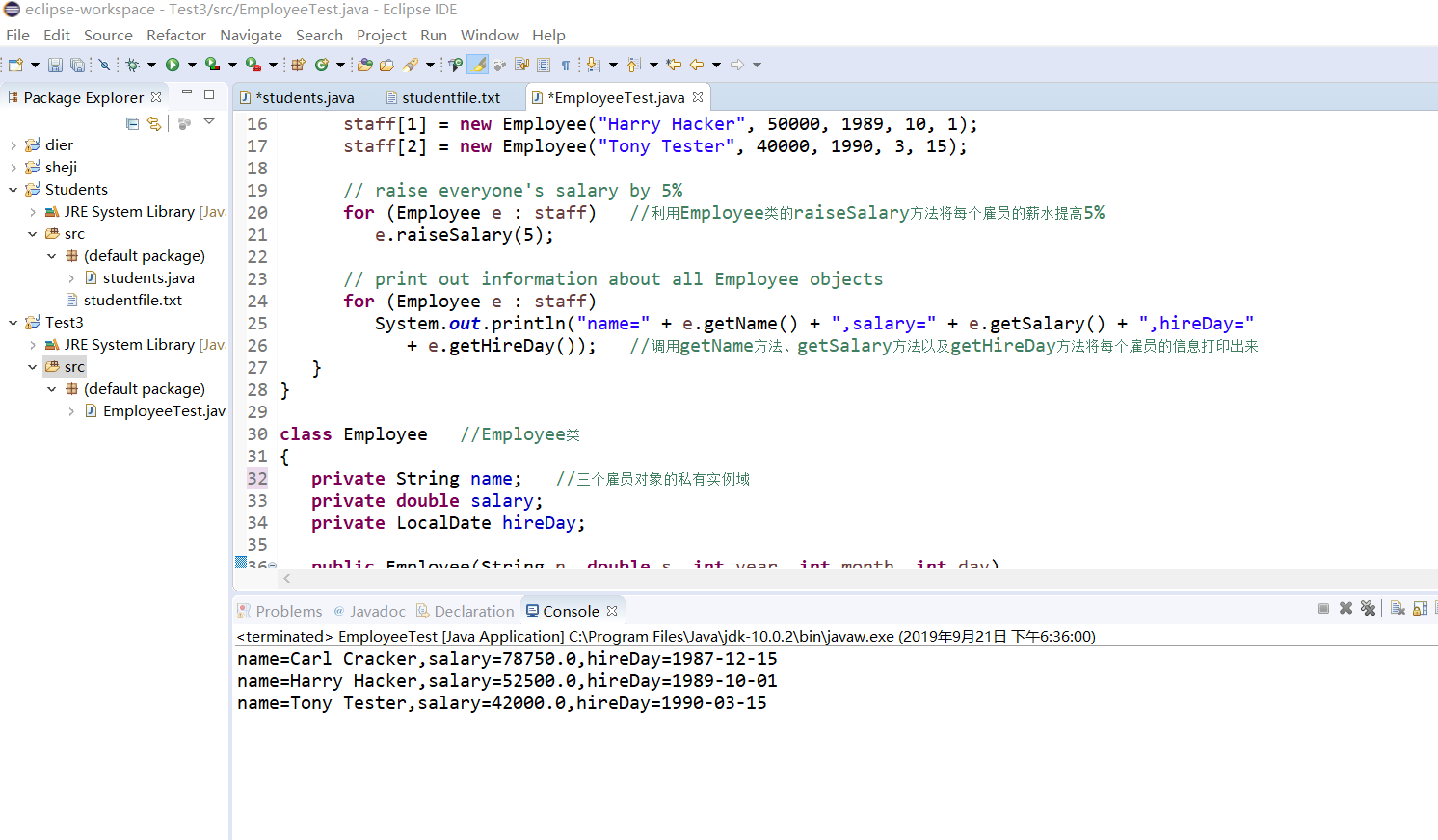
(2)
|
1
2
3
4
5
6
7
8
9
10
11
12
13
14
15
16
17
18
19
20
21
22
23
24
25
26
27
28
29
30
31
32
33
34
35
36
37
38
39
|
import java.time.LocalDate;public class Employee { private String name; //实例域定义 private double salary; //实例域定义 private LocalDate hireDay; //实例域定义 public Employee(String n, double s, int year, int month, int day) //构造器的定义 { name = n; salary = s; hireDay = LocalDate.of(year, month, day); } public String getName() //实例域name的访问器方法 { return name; } public double getSalary() //实例域Salary的访问器方法 { return salary; } public LocalDate getHireDay() ////实例域HireDay的访问器方法 { return hireDay; } public void raiseSalary(double byPercent) { double raise = salary * byPercent / 100; salary += raise; }} |
运行结果如下:

(3)代码如下:
|
1
2
3
4
5
6
7
8
9
10
11
12
13
14
15
16
17
18
19
20
21
|
public class EmployeeTest{ public static void main(String[] args) { // 用三个employee对象填充staff数组 Employee[] staff = new Employee[3]; staff[0] = new Employee("Carl Cracker", 75000, 1987, 12, 15); staff[1] = new Employee("Harry Hacker", 50000, 1989, 10, 1); staff[2] = new Employee("Tony Tester", 40000, 1990, 3, 15); // raise everyone's salary by 5% 给每人涨5%的工资 for (Employee e : staff) //进行foreach循环 e.raiseSalary(5); // print out information about all Employee objects for (Employee e : staff) System.out.println("name=" + e.getName() + ",salary=" + e.getSalary() + ",hireDay=" + e.getHireDay()); }} |
运行结果如下:

l 参考教材104页EmployeeTest.java,设计StudentTest.java,定义Student类,包含name(姓名)、sex(性别)、javascore(java成绩)三个字段,编写程序,从键盘输入学生人数,输入学生信息,并按以下表头输出学生信息表:
姓名 性别 java成绩
|
1
2
3
4
5
6
7
8
9
10
11
12
13
14
15
16
17
18
19
20
21
22
23
24
25
26
27
28
29
30
31
32
33
34
35
36
37
38
39
40
41
42
|
public class StudentTest { public static void main(String[] args) { // TODO Auto-generated method stub Student[] staff = new Student[3]; //构造了一个Employee数组,并填入了三个雇员对象 staff[0] = new Student("lulanxi", "female", 99); staff[1] = new Student("luhaonan", "male", 98); staff[2] = new Student("luyuxuan", "male", 97); for (Student e : staff) System.out.println("name=" + e.getName() + ",sex=" + e.getSex() + ",javascore=" + e.getJavascore()); //调用getName方法、getSex方法以及getJavascore法将每个雇员的信息打印出来 }}class Student //Employee类{ private String name; //三个雇员对象的私有实例域 private String sex; private int javascore; public Student(String n, String s, int score) { name = n; sex = s; javascore = score; } public String getName() { return name; } public String getSex() { return sex; } public int getJavascore() { return javascore; }} |
运行结果如下:

实验2 测试程序2(5分)
|
1
2
3
4
5
6
7
8
9
10
11
12
13
14
15
16
17
18
19
20
21
22
23
24
25
26
27
28
29
30
31
32
33
34
35
36
37
38
39
40
41
42
43
44
45
46
47
48
49
50
51
52
53
54
55
56
57
58
59
60
61
62
63
64
65
66
67
68
69
70
71
72
73
74
75
76
|
/** * This program demonstrates static methods. * @version 1.02 2008-04-10 * @author Cay Horstmann */public class StaticTest{ public static void main(String[] args) { // fill the staff array with three Employee objects Employee[] staff = new Employee[3]; //构造了一个Employee数组,并填入了三个雇员对象 staff[0] = new Employee("Tom", 40000); staff[1] = new Employee("Dick", 60000); staff[2] = new Employee("Harry", 65000); // print out information about all Employee objects for (Employee e : staff) { e.setId(); System.out.println("name=" + e.getName() + ",id=" + e.getId() + ",salary=" + e.getSalary()); ////调用getName方法、getId方法以及getSalary方法将每个雇员的信息打印出来 } int n = Employee.getNextId(); // calls static method 通过类名调用这个方法,只需要访问类的静态域 System.out.println("Next available id=" + n); //将其输出在控制台上 }}class Employee //Employee类{ private static int nextId = 1; //静态方法访问自身的静态域 private String name; //私有域 private double salary; private int id; public Employee(String n, double s) { name = n; salary = s; id = 0; } public String getName() { return name; } public double getSalary() { return salary; } public int getId() { return id; } public void setId() { id = nextId; // set id to next available id nextId++; } public static int getNextId() { return nextId; // returns static field } public static void main(String[] args) // unit test { Employee e = new Employee("Harry", 50000); System.out.println(e.getName() + " " + e.getSalary()); //输出在控制台上 }} |
运行结果如下:
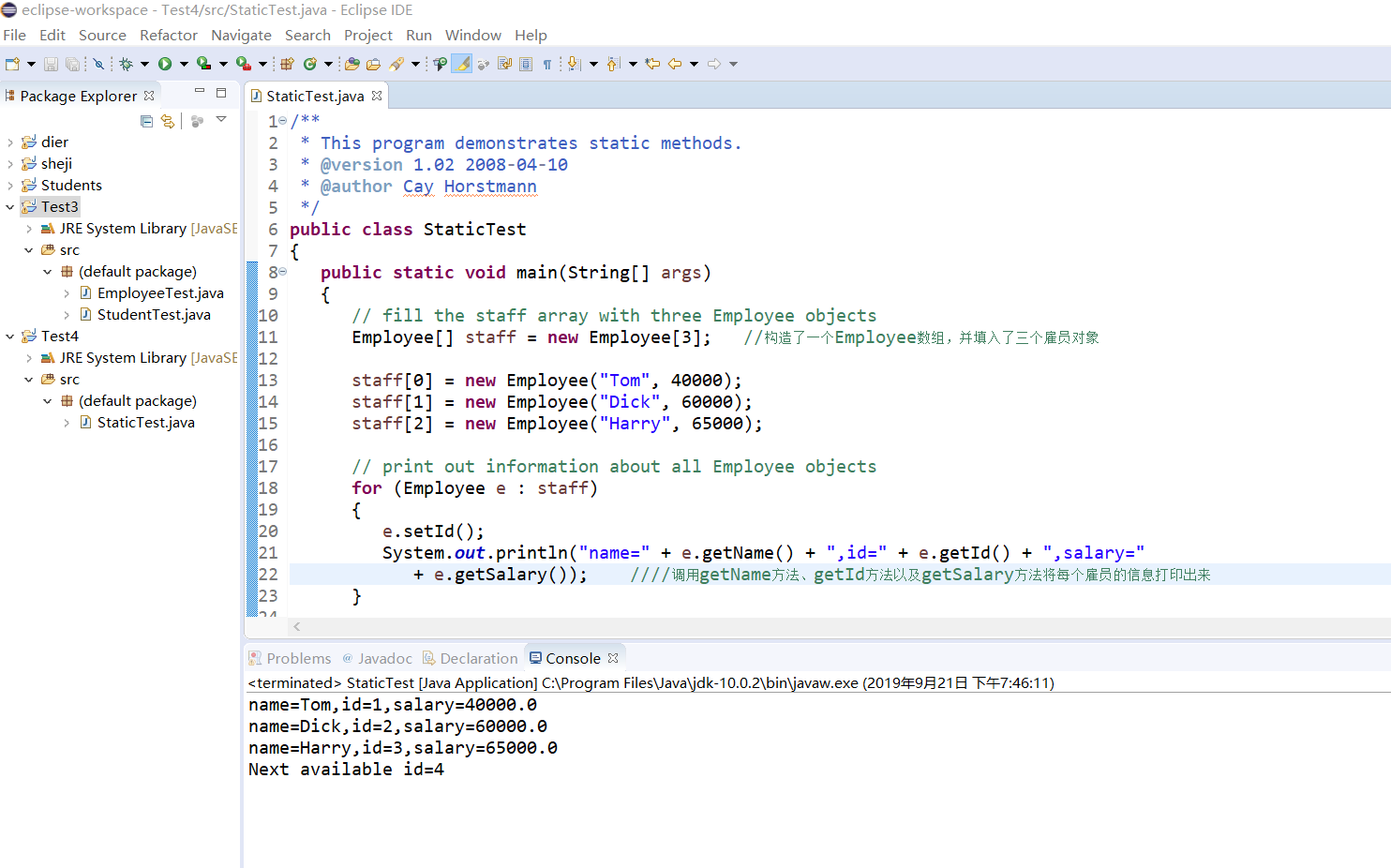
实验2 测试程序3(5分)
|
1
2
3
4
5
6
7
8
9
10
11
12
13
14
15
16
17
18
19
20
21
22
23
24
25
26
27
28
29
30
31
32
33
34
35
36
37
38
39
40
41
42
43
44
45
46
47
48
49
50
51
52
53
54
55
56
57
58
59
60
61
62
63
64
65
66
67
68
69
70
71
72
73
74
75
76
77
78
79
80
81
82
83
84
85
86
87
88
89
90
|
/** * This program demonstrates parameter passing in Java. * @version 1.01 2018-04-10 * @author Cay Horstmann */public class ParamTest{ public static void main(String[] args) { /* * Test 1: Methods can't modify numeric parameters */ System.out.println("Testing tripleValue:"); double percent = 10; //采用按值调用,然后再调用以下方法 System.out.println("Before: percent=" + percent); tripleValue(percent); System.out.println("After: percent=" + percent); /* * Test 2: Methods can change the state of object parameters */ System.out.println("\nTesting tripleSalary:"); Employee harry = new Employee("Harry", 50000); System.out.println("Before: salary=" + harry.getSalary()); tripleSalary(harry); System.out.println("After: salary=" + harry.getSalary()); /* * Test 3: Methods can't attach new objects to object parameters */ System.out.println("\nTesting swap:"); Employee a = new Employee("Alice", 70000); //按引用调用实现交换两个雇员对象状态的方法,但是并没改变存储在a和b中的对象引用 Employee b = new Employee("Bob", 60000); System.out.println("Before: a=" + a.getName()); System.out.println("Before: b=" + b.getName()); swap(a, b); System.out.println("After: a=" + a.getName()); System.out.println("After: b=" + b.getName()); } public static void tripleValue(double x) // doesn't work { x = 3 * x; //假定一个方法,将一个参数的值 增加到三倍,但是percent的值依旧是10 System.out.println("End of method: x=" + x); } public static void tripleSalary(Employee x) // works,对象引用作为参数,实现一个雇员的薪水提高两倍的操作,当调用harry = new Employee(。。。);tripleSalary(harry);实现改变对象参数的方法 { x.raiseSalary(200); System.out.println("End of method: salary=" + x.getSalary()); } public static void swap(Employee x, Employee y) //编写交换两个雇员对象状态的方法 { Employee temp = x; //swap方法的参数x和y被初始化为两个对象引用的拷贝。 x = y; y = temp; System.out.println("End of method: x=" + x.getName()); System.out.println("End of method: y=" + y.getName()); }} class Employee //simplified Employee class{ private String name; private double salary; public Employee (String n, double s) { name = n; salary = s; } public String getName() { return name; } public double getSalary() { return salary; } public void raiseSalary(double byPercent) { double raise = salary * byPercent / 100; salary += raise; }} |
运行结果如下:
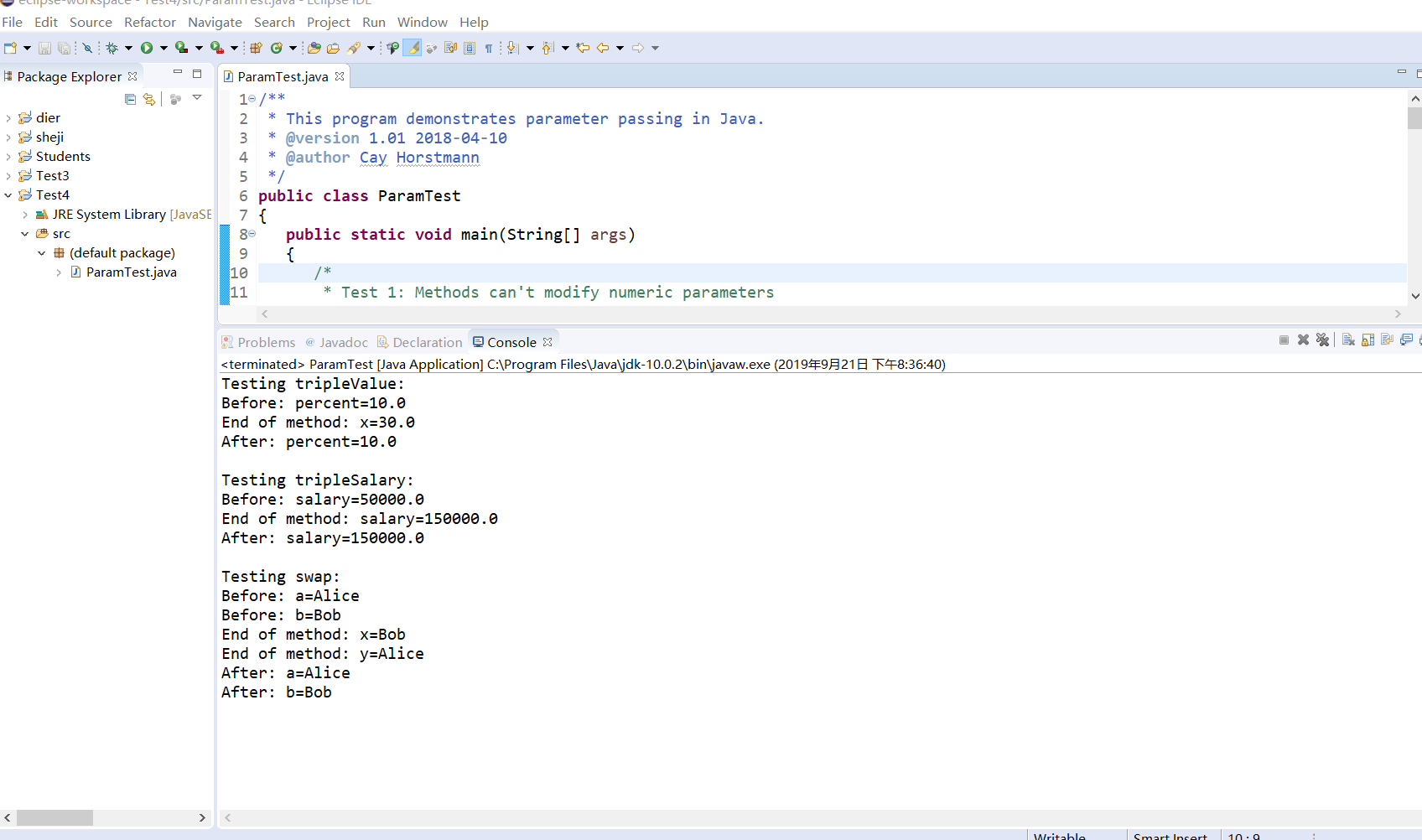
实验2 测试程序4(5分)
|
1
2
3
4
5
6
7
8
9
10
11
12
13
14
15
16
17
18
19
20
21
22
23
24
25
26
27
28
29
30
31
32
33
34
35
36
37
38
39
40
41
42
43
44
45
46
47
48
49
50
51
52
53
54
55
56
57
58
59
60
61
62
63
64
65
66
67
68
69
70
71
72
73
74
75
76
77
78
79
80
81
82
|
import java.util.*;/** * This program demonstrates object construction. * @version 1.02 2018-04-10 * @author Cay Horstmann */public class ConstructorTest { public static void main(String[] args) { // fill the staff array with three Employee objects Employee staff = new Employee[3]; //构建一个Employee类数组,并定义三个雇员对象 staff[0] = new Employee("Harry", 40000); staff[1] = new Employee(60000); staff[2] = new Employee(); // print out information about all Employee objects for (Employee e : staff) System.out.println("name=" + e.getName() + ",id=" + e.getId() + ",salary=" + e.getSalary()); //调用getName方法、getId方法以及getSalary方法将每个雇员的信息打印出来 }}class Employee //在执行构造器之前,先执行赋值操作,调用方法对域进行初始化,使每个雇员有一个id域{ private static int nextId; private int id; private String name = ""; // instance field initialization private double salary; // static initialization block static { Employee generator = new Random(); // set nextId to a random number between 0 and 9999 nextId = generator.nextInt(10000); } // object initialization block { id = nextId; nextId++; } // three overloaded constructors public Employee(String n, double s) //通常使用单个字符命名参数 { name = n; salary = s; } public Employee(double s) { // calls the Employee(String, double) constructor this("Employee #" + nextId, s); } // the default constructor public Employee() { // name initialized to ""--see above // salary not explicitly set--initialized to 0 // id initialized in initialization block } public String getName() { return name; } public double getSalary() { return salary; } public int getId() { return id; }} |
运行结果如下:
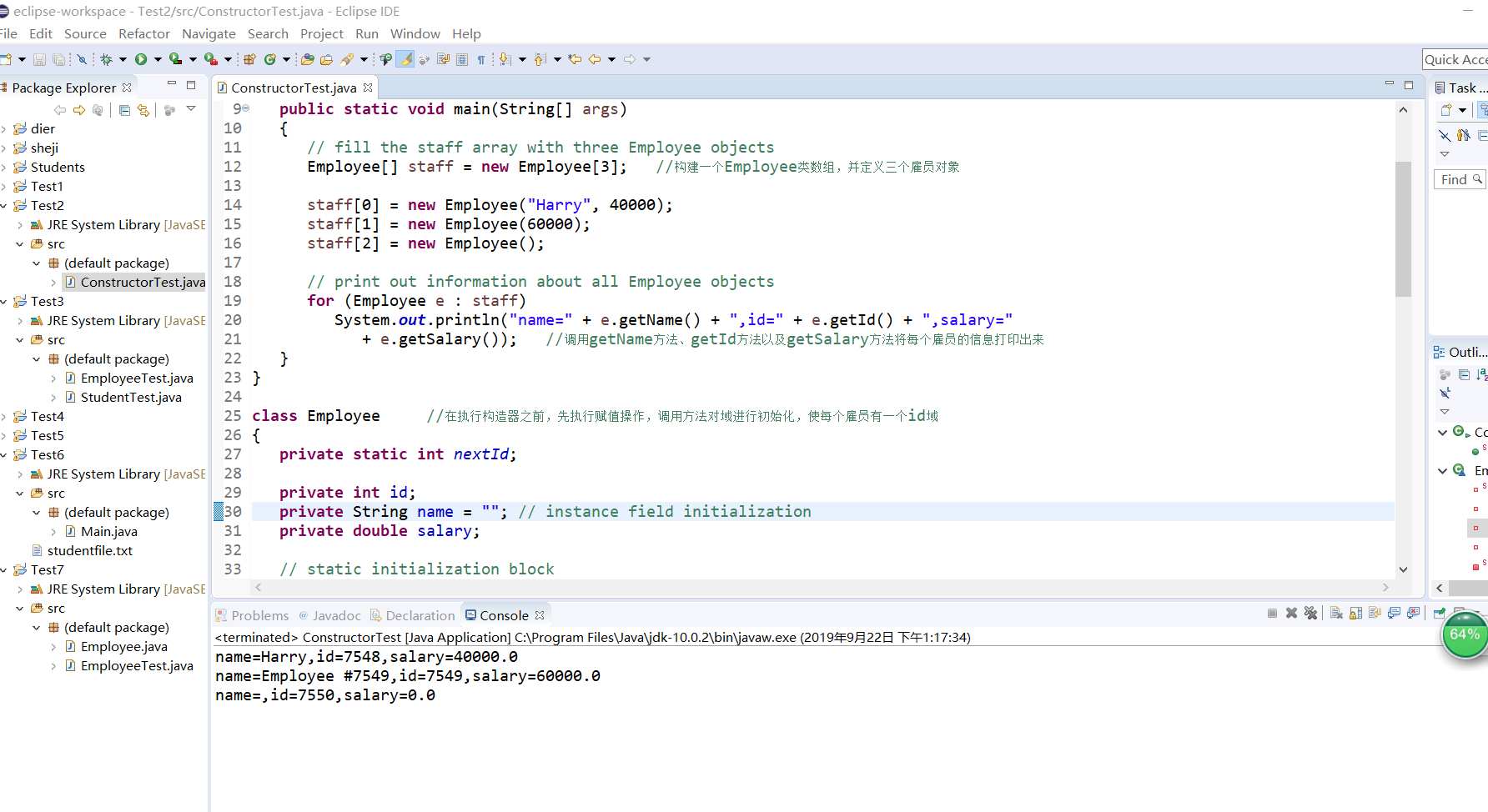
实验2 测试程序5(5分)
实验4.6代码
|
1
2
3
4
5
6
7
8
9
10
11
12
13
14
15
16
17
18
19
20
21
22
23
24
|
import com.horstmann.corejava.*; //将类放入一个包中,将包的名字放在源文件的开头,包中定义类的代码之前// the Employee class is defined in that packageimport static java.lang.System.*;/** * This program demonstrates the use of packages. * @version 1.11 2004-02-19 * @author Cay Horstmann */public class PackageTest{ public static void main(String[] args) { // because of the import statement, we don't have to use // com.horstmann.corejava.Employee here Employee harry = new Employee("Harry Hacker", 50000, 1989, 10, 1); // harry.raiseSalary(5); //按值调用 // because of the static import statement, we don't have to use System.out here out.println("name=" + harry.getName() + ",salary=" + harry.getSalary()); //将其输出在控制台上 }} |
实验4.6运行结果:
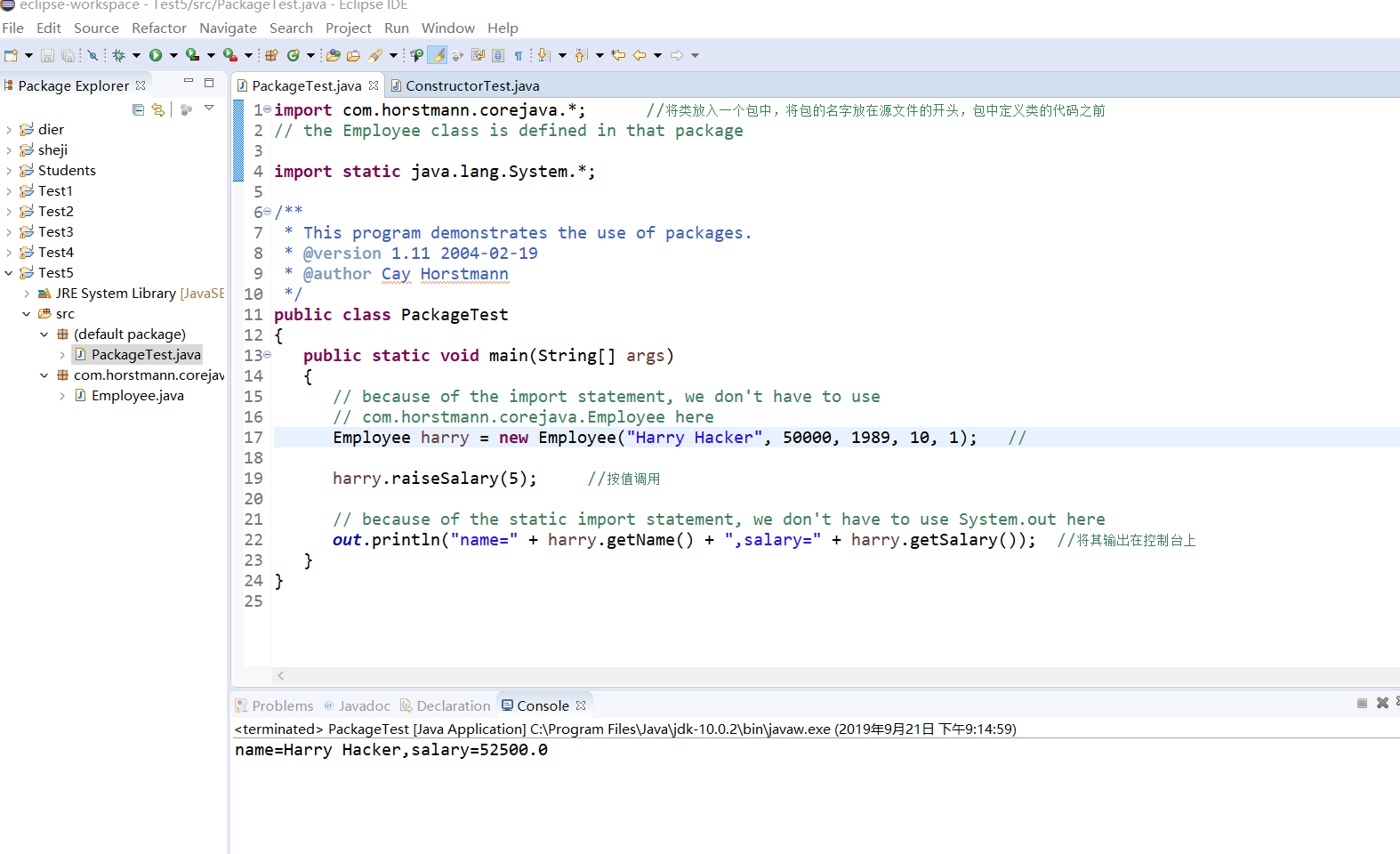
实验4.7代码
|
1
2
3
4
5
6
7
8
9
10
11
12
13
14
15
16
17
18
19
20
21
22
23
24
25
26
27
28
29
30
31
32
33
34
35
36
37
38
39
40
41
42
43
44
45
46
|
package com.horstmann.corejava;// the classes in this file are part of this packageimport java.time.*; // import statements come after the package statement/** * @version 1.11 2015-05-08 * @author Cay Horstmann */public class Employee //Employee类放置在com.horstmann.corejava包中{ private String name; private double salary; private LocalDate hireDay; public Employee(String name, double salary, int year, int month, int day) { this.name = name; this.salary = salary; hireDay = LocalDate.of(year, month, day); } public String getName() { return name; } public double getSalary() { return salary; } public LocalDate getHireDay() { return hireDay; } public void raiseSalary(double byPercent) { double raise = salary * byPercent / 100; salary += raise; }} |
运行结果如下:
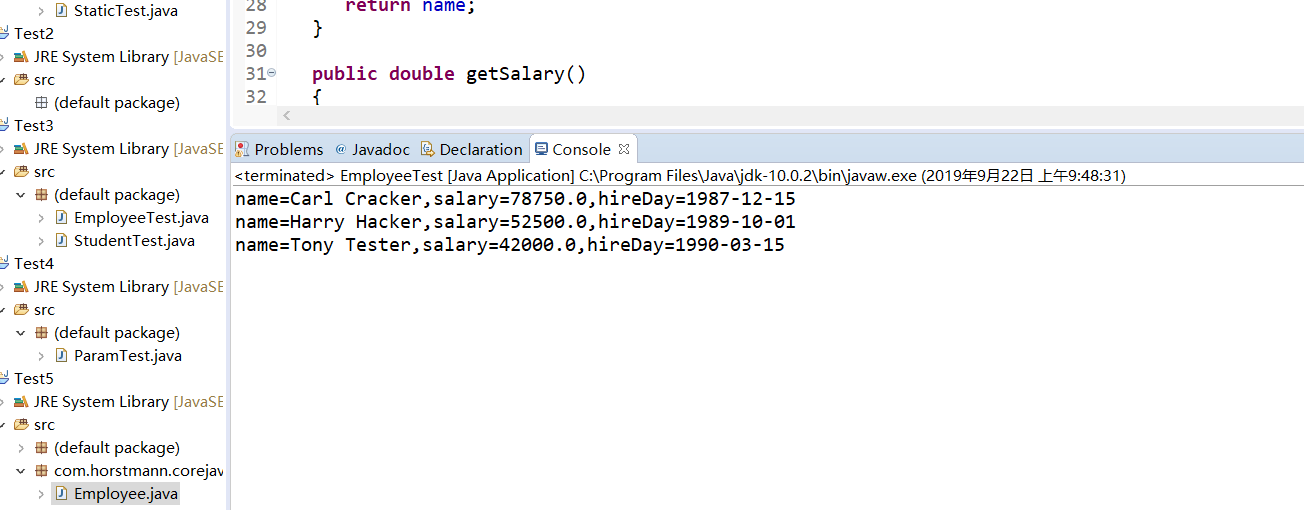
第三部分:实验总结
本次实验首先是编译运行程序了解文件的输入输出,在实验三的基础上,进一步使用student类编写了一个Java程序。通过本次实验,我进一步了解到对象与类的定义以及各自的特点。了解了静态域、静态常量、静态方法、工厂方法和main方法的概念,并通过实例程序去真正理解了这些概念。接着学习了对象构造,在这一节主要就学习了参数化,初始化块。最后又学习了包,虽然在之前已经解除了包这个概念,但在这一节有学习了新的概念,比如说类的导入、静态导入、将类放入包中。大致掌握了用户自定义类的语法规则,如实例域、静态域、构造器方法、更改器方法、访问器方法、静态方法、main方法、方法参数的定义要求等。





 浙公网安备 33010602011771号
浙公网安备 33010602011771号